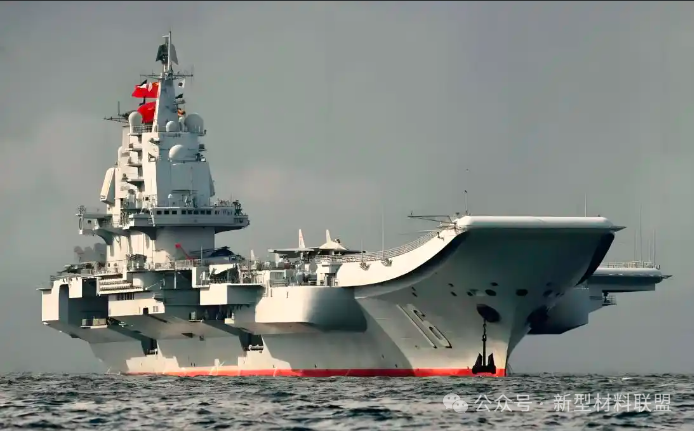Future Aircraft Carrier's Demand for New Materials
On the afternoon of September 25, during a regular press conference held by the Ministry of National Defense, Senior Colonel Zhang Xiaogang, spokesperson for the Ministry of National Defense, stated in response to a reporter's question that recently, the J-15T, J-35, and KJ-600 carrier-based aircraft successfully conducted catapult takeoff and landing training on the Fujian aircraft carrier. This marks that the Fujian has acquired the capability for electromagnetic catapult and recovery, laying a solid foundation for the integration of various carrier-based aircraft into the aircraft carrier battle group system. This achievement holds milestone significance in the development history of China's aircraft carriers.

The future aircraft carrier, as a core equipment for maritime combat platforms, will have multi-dimensional and high-standard requirements for material performance, mainly reflected in the following aspects:
Lightweight and high strength
Carbon fiber composites, due to their greater strength compared to steel, lower density than aluminum, and resistance to corrosion and high temperatures, are set to become key materials for aircraft carrier decks and hull structures. For example, the F-35 fighter jet achieves weight reduction by using 35% carbon fiber composites.
Metal 3D printing topology optimization: Achieving lightweight components through topology optimization design while maintaining structural strength. The U.S. Army has used this technology to manufacture tank chassis, resulting in reduced costs and improved performance.
2. Performance in Extreme Environments
High-temperature resistant materials: Aircraft carrier decks must withstand the high-temperature exhaust flames during the takeoff and landing of carrier-based aircraft, requiring the use of titanium alloys or ceramic matrix composites.
Corrosion-resistant materials: Long-term marine environments require materials to have salt spray corrosion resistance, such as stainless steel or special coating technology.
3. Rapid Manufacturing and Repair Capability
3D Printing Technology: The shipboard 3D printing system can quickly repair non-standard parts such as gears and couplings. The Chinese Navy has achieved on-board printing repairs for warship gears.
Additive manufacturing technology: Metal 3D printing can shorten the production cycle of complex components, such as those used by China Aerospace Science and Industry Corporation for missile parts manufacturing.
4. Electromagnetic Compatibility and Stealth Performance
Electromagnetic shielding materials: Carbon fiber composites possess conductivity, which can reduce electromagnetic signal leakage.
Stealth coating: It is necessary to combine radar-absorbing material (RAM) to reduce the radar cross-section of the aircraft carrier.
5. Supply Chain Security and Localization
Strategic material independence and control: The supply of rare earth element samarium directly affects military production, and China has already influenced the Western ammunition supply chain through supply cut strategies.
According to the new policy for 2025 on information technology application innovation, military materials must be developed based on domestic chips and operating systems to ensure supply chain security.
Note: The advanced manufacturing technologies showcased in the enormous factory of AVIC Shenyang Aircraft Corporation may involve future aircraft carrier material processing techniques.
6. Intelligent and Multifunctional Integration
Smart materials, such as shape memory alloys, can adapt to environmental changes and enhance the self-repairing capability of aircraft carrier structures.
Multifunctional composites: possessing structural load-bearing and energy storage characteristics (such as supercapacitors), reducing the complexity of aircraft carrier systems.
【Copyright and Disclaimer】The above information is collected and organized by PlastMatch. The copyright belongs to the original author. This article is reprinted for the purpose of providing more information, and it does not imply that PlastMatch endorses the views expressed in the article or guarantees its accuracy. If there are any errors in the source attribution or if your legitimate rights have been infringed, please contact us, and we will promptly correct or remove the content. If other media, websites, or individuals use the aforementioned content, they must clearly indicate the original source and origin of the work and assume legal responsibility on their own.
Most Popular
-

Zf asia-pacific innovation day: Multiple Cutting-Edge Technologies Launch, Leading Intelligent Electric Mobility
-

Mexico officially imposes tariffs on 1,400 chinese products, with rates up to 50%
-

Fire at Sinopec Quanzhou Petrochemical Company: 7 Injured
-

List Released! Mexico Announces 50% Tariff On 1,371 China Product Categories
-

Argentina Terminates Anti-Dumping Duties on Chinese PVC Profiles! Kingfa Technology & Siemens Sign Digital and Low-Carbon Cooperation Agreement






